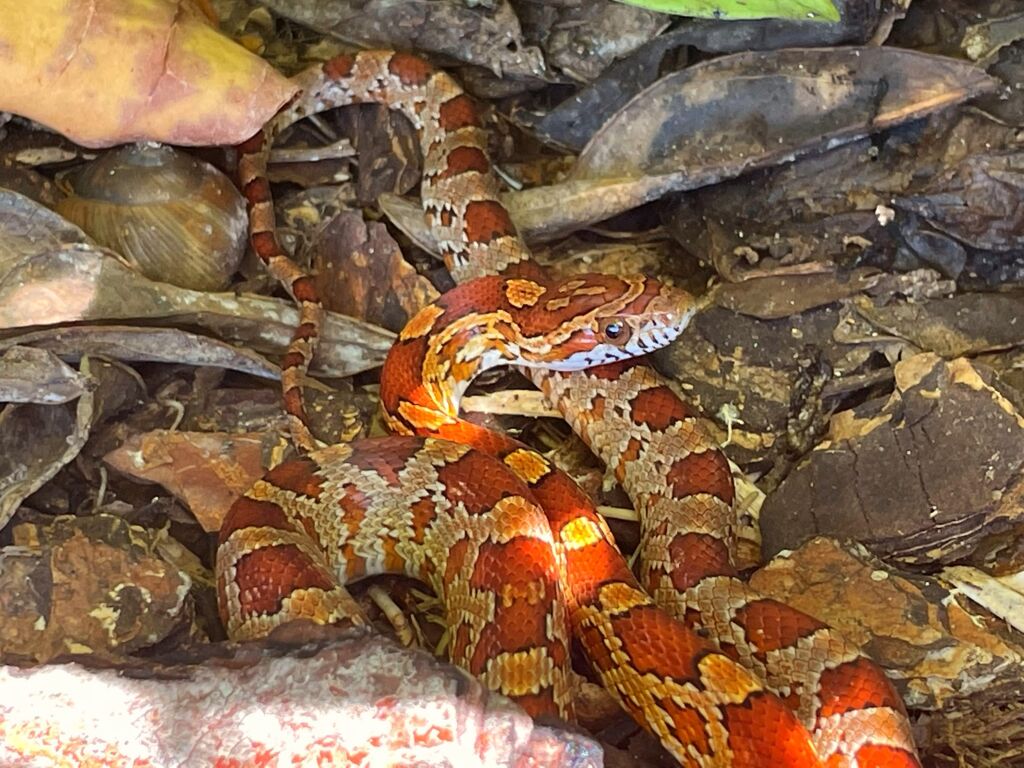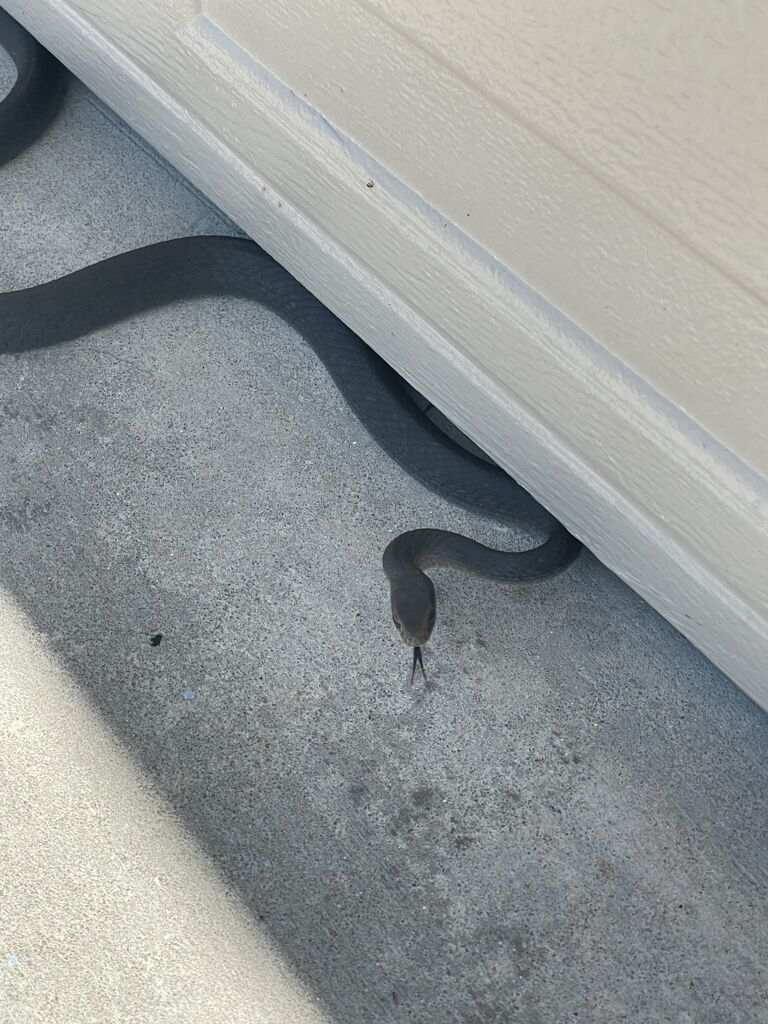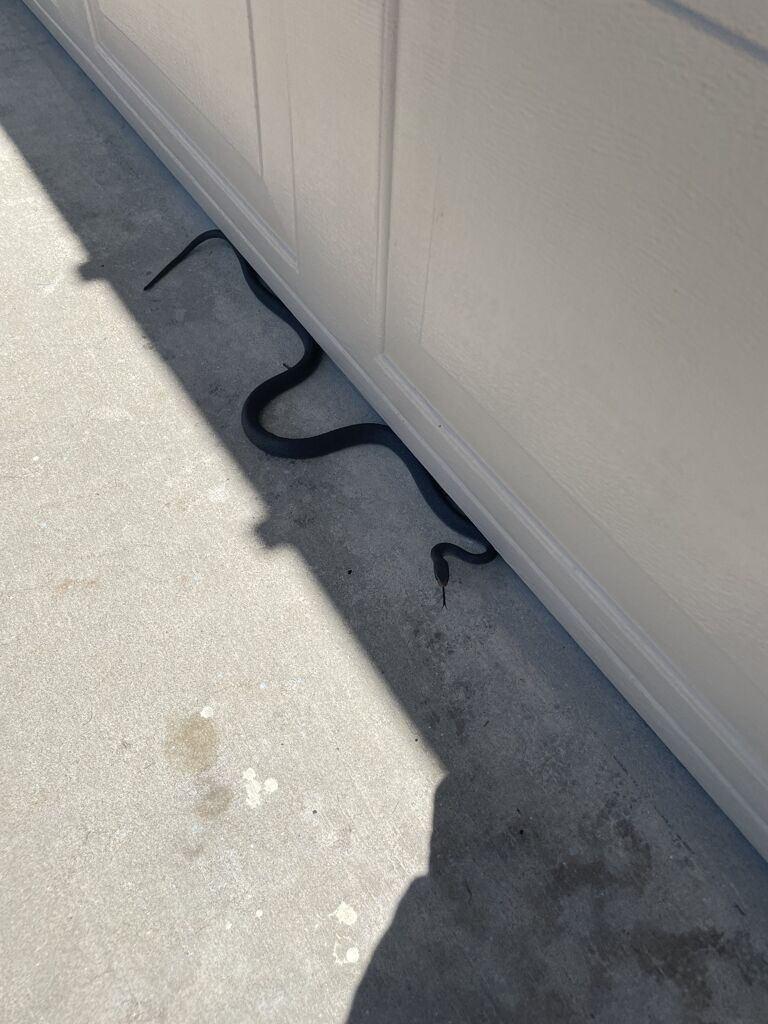
Florida is home to a remarkable variety of snake species. Among the many fascinating reptiles that inhabit the Sunshine State, rat snakes, black racers, and banded water snakes stand out for their distinct characteristics and widespread presence. In this essay, we will delve into the identification features of each species, discuss their habitats, feeding habits, and explain why these snakes pose no significant threat to humans. These snakes are the most common snakes we find in Volusia, Seminole, Lake, Orange and Flagler counties. Our technicians at Dave’s Pest Control can safely remove snakes from your home or business should you find one.
Rat Snakes:
Rat snakes, also known as corn snakes, are non-venomous constrictors that exhibit remarkable color variations. They can be identified by their slender bodies, keeled scales, and large, round eyes. Their colors range from vibrant yellows and oranges to browns, blacks, and even gray.
Rat snakes are commonly found in both rural and urban areas throughout Florida. Homeowners are most likely to encounter these snakes near overgrown vegetation, in barns or sheds, or near human settlements where rodents are prevalent. Rat snakes are excellent climbers and may be observed in trees, fences, or even attics.
As opportunistic hunters, rat snakes primarily feed on small mammals such as rats, mice, and occasionally birds. This diet makes them valuable allies to homeowners by helping to control rodent populations naturally.
Rat snakes play an essential role in controlling rodent populations, which helps maintain ecological balance. By preying on rats and mice, they can help reduce damage to crops and prevent the spread of diseases carried by rodents.
Rat snakes are constrictors, meaning they capture and kill their prey by coiling their bodies around them to suffocate them. Their diet primarily consists of small mammals, such as rats, mice, and squirrels. They are also known to consume birds, eggs, and occasionally reptiles. Rat snakes are adaptable and can thrive in a variety of habitats. In Florida, they can be found in forests, woodlands, marshes, swamps, and even residential areas. They often seek out areas near a water source, as they are excellent swimmers.

Black Racer Snakes:
Black racer snakes, also referred to as eastern racers, are sleek and fast-moving snakes known for their jet-black coloration. However, it’s important to note that juvenile black racers often have gray or brown hues, which gradually darken as they mature. They have smooth scales and a slender, elongated body.
These snakes are widespread throughout Florida, making them a common sight in various habitats such as forests, grasslands, swamps, and even suburban areas. Homeowners are likely to encounter black racers in yards, gardens, or open fields, where they actively hunt for prey.
Black racers are diurnal hunters and primarily consume small vertebrates like lizards, frogs, birds, and rodents. Their speed and agility aid them in catching their quarry, contributing to a healthy balance in the ecosystem.
Black racers are known for their remarkable speed and agility. They are excellent climbers and swimmers, but they are most famous for their quickness on land. They can swiftly reach speeds of 4 to 8 miles per hour (6.4 to 12.9 kilometers per hour) when fleeing from potential threats.
Black racer snakes are known to be alert and highly aware of their surroundings. When approached or threatened, they often exhibit aggressive behavior, including rapid tail vibrations and striking with their mouth closed.
While black racers are skilled predators, they also face predation themselves. Several animals, including birds of prey, larger snakes like kingsnakes or indigo snakes, raccoons, and even domestic cats and dogs, can prey upon them.
When threatened, black racer snakes have a few defense mechanisms. Besides their speed and agility, they can also flatten their bodies, hiss loudly, and release a foul-smelling musk to deter potential predators.
Juvenile black racers have a different color pattern compared to adults. While adult black racers are typically solid black, juveniles have a pattern of dark blotches or spots on a gray or brown background. The blotches may be more prominent towards the head and neck and become less distinct towards the tail.
Like adult black racers, juveniles have smooth scales. These scales give them a sleek appearance and allow for easy movement through various habitats.
Juvenile black racers are smaller than adults. They typically measure between 6 to 12 inches in length when they hatch and continue to grow as they age.
Juvenile black racers have a slender and elongated body shape, which enables them to move quickly. Their bodies are designed for agile movements and effective navigation through vegetation.
Similar to adult black racers, juveniles are known for their speed and agility. They are active during the day, quick to flee when threatened, and can move swiftly on the ground or even climb low vegetation or trees.
As the juvenile black racers mature, their coloration gradually changes to a solid black as they lose their juvenile patterning. This transformation usually occurs within the first year or two of their lives.

Banded Water Snakes:
Banded water snakes, sometimes mistaken for venomous water moccasins, are non-venomous snakes that inhabit aquatic environments. They can be identified by their dark-colored bodies with distinct bands on their jaws, which venomous cotton-mouths do not have.
While banded water snakes are generally non-aggressive and harmless to humans, they may bite if they feel threatened or cornered. However, their bite is non-venomous and typically harmless, causing only minor injuries. When disturbed, they may release a pungent musk as a defensive mechanism.
Banded water snakes often mimic the appearance of venomous water moccasins (Agkistrodon piscivorus), which helps protect them from potential predators. This mimicry involves displaying similar coloration and patterns, as well as adopting similar defensive postures when threatened.
These snakes are commonly found near bodies of water, such as lakes, ponds, marshes, and slow-moving streams, making Florida’s wetlands their preferred habitats. Homeowners living near these environments may encounter banded water snakes when engaging in outdoor activities like gardening or fishing.
Feeding predominantly on fish, amphibians, and small aquatic creatures, banded water snakes play a crucial role in maintaining the ecological balance of Florida’s aquatic ecosystems. By keeping populations of fish and amphibians in check, they contribute to the health and stability of the wetland ecosystems they call home.
Non-harmful Nature of Florida Snakes:
While encountering snakes can often evoke fear or concern, it’s important to note that rat snakes, black racers, and banded water snakes pose little to no threat to humans. These species are non-venomous and generally shy in nature, preferring to retreat from potential threats rather than confront them.
Their diets, as mentioned earlier, mainly consist of small vertebrates such as rodents, amphibians, and fish. Snakes play a crucial role in maintaining balanced ecosystems by controlling the populations of these animals, reducing the spread of diseases they may carry, and preventing ecological imbalances.

Snakes in Florida, like snakes in other parts of the world, reproduce sexually. They exhibit a variety of reproductive strategies, but the most common method among snakes is internal fertilization. Let me explain the general process of snake reproduction.
Courtship: During the breeding season, male snakes actively search for receptive females. They use a combination of chemical signals (pheromones), visual cues, and behavioral displays to attract females and establish courtship. These displays can involve body movements, rubbing against the female’s body, or even combat with other males to win the opportunity to mate.
Mating: Once a male successfully courts a female, mating takes place. Snakes have a pair of reproductive organs called hemipenes, which are located inside the base of the tail. During mating, the male inserts one of his hemipenes into the female’s cloaca, a common opening used for reproduction and waste elimination.
Fertilization: After mating, internal fertilization occurs within the female snake’s body. The male’s sperm is transferred to the female and travels to the oviducts, where fertilization of the eggs takes place. Fertilized eggs develop into embryos.
Egg Development: Most snake species are oviparous, meaning they lay eggs. The female snake carries the fertilized eggs within her body for a certain period, allowing the embryos to develop. The duration of gestation can vary depending on the species.
Egg Laying: When the embryos have fully developed, the female snake lays the eggs. The number of eggs laid can vary significantly between snake species, ranging from a few to several dozen. Some snake species may deposit their eggs in protected locations, such as underground burrows or decaying vegetation, while others may lay them in open areas.

Incubation: Once the eggs are laid, the environmental conditions, particularly temperature and humidity, play a crucial role in the development of the embryos. The eggs are typically left unattended by the female. The time it takes for the eggs to hatch can vary depending on the species and environmental conditions.
Hatching: When the conditions are suitable, the snake embryos inside the eggs undergo development, eventually leading to hatching. The hatchlings emerge from the eggs, and they are usually self-sufficient from the moment they hatch.
Florida’s snake population is rich and diverse, with rat snakes, black racers, and banded water snakes standing out as notable examples. By understanding their identification features, preferred habitats, and diets, homeowners can coexist peacefully with these non-venomous snakes. Appreciating the role these reptiles play in controlling pest populations and maintaining ecological balance is essential for fostering a harmonious relationship with Florida’s captivating wildlife.
If you see one more bug, call Dave’s!
